
How to Care for Your Teeth & Gums
Click on any service name below for more details of that particular procedure.
How to Brush Your Teeth
The first step is to choose a good toothbrush. You always want to use a soft brush with a small head. A soft brush is hard enough to remove plaque, yet gentle enough not to damage your teeth or gums.
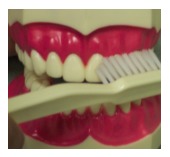
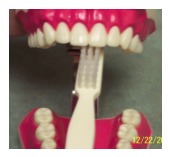
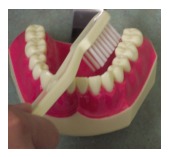
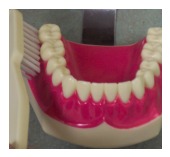
The next issue is to select good toothpaste. In general, any toothpaste that contains Fluoride will do the job. Patients with sensitive teeth can try products like Sensodyne to help reduce discomfort.
The first rule of brushing is to divide your mouth up into four quadrants (top left, top right, bottom left, bottom right). Brush your teeth from front to back, moving from left side of your mouth to the right, or right to left. This way you won’t miss any area. Usually a pea-sized amount of toothpaste is enough.
There are a variety of techniques for brushing your teeth, but one of the most popular ones is described here:
- Hold the brush at a 45 degree angle toward the teeth and gums. Start brushing in small concentric circles. Repeat this motion 6 to 10 times and move on to the next area of 2 to 3 teeth.
- On chewing surfaces, short strokes work best to get the plaque out of the grooves and pits.
- When brushing the back side of your front teeth, hold your brush vertically to be able to reach the teeth better and close slightly to better clean behind to top molars.
- An adequate brushing should take at least 2 minutes and preferably around 4 minutes.
As far as frequency of brushing is concerned, ideally you want to brush your teeth after each meal. But if you can’t, brush at least twice a day – after breakfast and before going to bed. If you live in or around Prescott Valley and Chino Valley, give us a call today to schedule your oral health evaluation exam.
How to Floss Your Teeth
The surfaces between teeth are not easily accessible by toothbrush; therefore, the best way to clean them is by flossing. The ideal frequency for flossing is like brushing: ideally after each meal, though one time a day (before going to bed) is the minimum necessary.
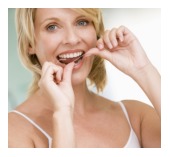
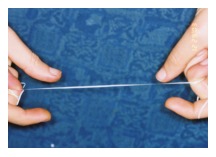
To start, cut a piece of dental floss (approximately 2 feet). Wrap both sides of the floss around your middle fingers. Using your index and thumb, glide the floss in between all of your teeth one by one. When flossing, make sure you are not cutting your gums. The goal is to clean the teeth surfaces, not the gums. In the space in between the teeth, press the floss against each side of the tooth (hug the tooth) and gently move it back and forth and up and down. Then move to the opposite surface of the adjacent tooth.
If you have any questions about flossing your teeth and you live in Prescott Valley and Chino Valley or the surrounding area, give us a call today!
Electric vs. Manual Brush
There have been multiple studies comparing the effectiveness of manual brushes and electric brushes.
Although not all electric brushes are the same, these studies conclude that, in general, electric brushes are more efficient in controlling plaque than manual brushes. Theoretically, you can do a very good brushing with a regular hand brush, but the movements of an electric brush make the task easier and more effective.
Also, some electric brushes (Sonicare) produce sonic vibrations that are difficult to mimic with a hand brush. Other electric brushes like Oral-B and Rotadent have small heads that help you access hard-to-reach areas of your mouth. This aspect is more important when you are talking about someone with orthodontic braces or a history of gum disease.
If you have any questions about electric toothbrushes and you live in Prescott Valley and Chino Valley or the surrounding area, give us a call today!
Bad Breath
There are a few different causes of bad breath. Ranging from stomach problems to diet and teeth problems, most of the causes can be found in the mouth. They are:
- Tongue (when bacteria grows in between the papilla)
- Teeth cavities (especially when food particles get stuck in them)
- Gum diseases
- Extraction sites during healing
- Dentures when not cleaned properly
- Alcohol and tobacco
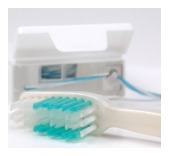
If you or someone you know is concerned about bad breath, the first step is a dental check up. Your dentist will be able to confirm or rule out the source of the bad breath.
When the cause is found, treatment will be determined and explained by your dentist. If the source of the bad breath is your mouth, there is little chance that mouth washes or mints can treat the problem. They usually mask the problem for a short period of time, and can sometimes exacerbate the situation (mouthwashes that contain alcohol cause dry mouth and usually make the bad breath worse).
These are a few other, non-dental reasons that cause bad breath:
- Sore throat
- Tonsillitis
- Some food
- Infection of air passages
Following a good oral hygiene routine and receiving regular dental check ups are the best ways to prevent bad breath. If you live in or around Prescott Valley and Chino Valley, give us a call today to schedule an appointment and get rid of bad breath forever!
Dental Health and Your Diet
Sugar is the main cause of dental decay when bacteria are present. However, the frequency of your sugar consumption is more significant than the amount of sugar you eat.
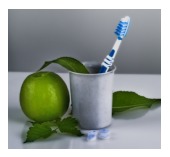
Probably the worst thing you can do to your teeth is to drink a soda and have a sip every few minutes over a long period of time; the same is true for snacking. It is recommended that if you want to have a snack, soda, or juice, it is better to have it after food, as dessert, or have it in one sitting. Eating or drinking something sweet over an extended period of time creates a constant supply of sugar for bacteria that causes tooth decay.
It is important to be aware of all the possible sources of sugar out there. It is not just everything that is sweet, but anything that can turn to sugar, like pieces of bread. Cutting down your sugar intake is good for cavity prevention, as well as your general health.
But what about when you have to have sugar? The best way to avoid cavities is to prevent the sugar from staying next to your teeth. Brushing after eating sugar, rinsing your mouth with Fluoride mouth wash, or chewing sugarless gum can help. However, nothing has the effect of avoiding sugar.
Is there any kind of food that prevents tooth decay? Well, not really. Some people believe that chewing foods like apples and carrots may have some plaque removal effects, but they still contain some sugar, so any advantage is not clear.
Another group of food that causes significant damage to teeth structure is acidic food. If in frequent contact with teeth, things like limes, lemons, and grapefruits can cause serious irreversible damage (erosion) to your teeth.
If you live in or around Prescott Valley and Chino Valley, or surrounding areas, don’t hesitate to call us with your oral health questions.
Fluoride and Decay Prevention
Many years ago scientists started to notice that children who were born and raised in areas with natural fluoride in drinking water had fewer cavities than children in other areas. Fluoride absorbed by your body when teeth were forming (during mother’s pregnancy to early childhood) integrates into the structure of enamel and makes it stronger.
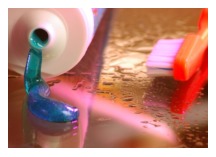
After teeth eruption, fluoride found in your toothpaste, mouthwash, or in what your dentist places on your teeth still has a positive effect on your teeth. It strengthens the enamel and reduces the chance of tooth decay.
If you have children and live in an area that has no fluoride in its drinking water, you should consult your dentist and physician about fluoride tablets that are available for children.
If you have any questions about Fluoride treatment and you live in Prescott Valley and Chino Valley or surrounding area, give us a call today!
View our Video Library of Dental Care Videos
Use the left or right arrow on each edge of the image below to navigation through our video collection.
